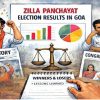Goa is abuzz with excitement as vintage bike and car owners, users, collectors and fans are decking […]

Rajan Narayan MEMOIRS OF AN UNDERDOG JOURNALIST! “I have no sacred cows!’ `I’m the goonda with the pen!” BUILDING GO BRAND EQUITY!
Aug 17* Aug 23 2024, Life & Living August 16, 2024By Rajan Narayan
I REALIZED quite early that sustaining an independent media organization is very different from working for somebody else who’s an employer, boss or owner of a publication. For the first three decades of my working life in the media in Mumbai in the 1970 and later on in Goa in the 1980s and 1990s plus I could take it for granted that at the end of the month I would get some salary however miserable it was. I depended on that to live from month to month.
But in 2003 when I left the OHeraldo and started promoting my very own political weekly, the Goan Observer, I not only had to worry about my salary but the salaries of those who were my employees and colleagues. I had to worry about finding the money to print week after week to pay of office rental, staff salaries, cost of printing the weekly, plus give the wife some money to keep us going comfortably if not frugally.
Distribution of the Goan Observer across Goa was yet another headache to come to terms with. This is not simple for the weekly had to reach over a hundred outlets in Goa by 6 am every Saturday morning so that the copies further got delivered to the homes of subscribers. I had to focus on raising money through advertising and distribution revenue which would come in. Since we were a new organization I also had to generate a surplus to invest in office equipment needed.
Investment in computers had to be made very carefully for they would become obsolete very rapidly. Maintenance costs were always a drain on resources. More expensive than hardware is software which had to be constantly upgraded vis-à-vis designed software and computer capacity. Office furniture has to be comfortable for working.
Going by my bitter experience in the OHeraldo and elsewhere in Bombay before that, I had to find office premises with not only enough space and ventilation but also enough washrooms. Since I thought of myself as an enlightened entrepreneur and equipped our rented office spaces with a kitchen with a gas stove and enough equipment to serve tea and coffee, plus a water filtar was installed. We even had a microwave for the benefit of the staff to heat up whatever they wished by way of refreshment.
Fortunately, the idea of the weekly Goan Observer caught on with Goans and we attracted a reasonable amount of advertising. All thanks to the goodwill I had built up and my reputation for being a fair and independent journalist and editor. But independent journalism is a double-edged sword. Is you expose corruption in high places in government the government advertising will stop coming in. If you antagonize big private companies and their misdeeds, they may boycott you.
Unfortunately, while everyone may publically praise you, it is not in the interest of business and industry or even the government of the day to promote critical journalism. If you build up a brand based on unbiased and even fearless journalism than you have to continue to adopt an aggressive stand. The more aggressive you are politically the less advertising you are likely to get.
So much so that I soon realized that no media organization can depend entirely on the fortunes of the core brand. You need to develop and grow brand extensions which will supplement and complement income from the publication. We may complain about the Times of India commercializing the brand. It is not the TOI which is the only or main source of revenue for the TOI group. On the contrary, it is the optimization of the brand value which is the core of the revenue model of the TOI. There are magic tricks in the TOI real estate business. There is times education and time parenting and Radio Mirchi which is the radio station. There is TOI television channel.
I recall a discussion on the TOI, with the then MD, Murli Kumar, of The Hindu while in Cuba way back in 2006. The Hindu is and continues to attempt to be an independent media organization. Murli told me that while they deplored the commercialization of media by the Times, they could not but admire the revenue model. Perhaps the most blatant brand extension is the “Bombay Times” and “Goa Times.” The lifestyle supplements which accompany all Times of India editions are completely monetized revenue models. The pages here cater to those who suffer enough vanity to see their name and photographs of family and friends in the paper, call them the social pages.
The TOI management got very upset when the paper came to Goa and soon enough learned that Goan industrialists and upper crust society is made up of reserved and very private people who do not seek or crave for publicity in the media. In fact, unlike the Ambani family, when the children of Goan industrialists get married it is a private function and media is not invited officially to cover the marriage.
It is possible to diversify and strengthen the income of independent media houses without compromising on independence. At the Goan Observer in the early years we discovered the potential of desktop publications almost by accident. An NRI friend of ours, Ben Antao, asked us if we could publish a collection of his articles? Ben Antao was a Goan who lived in Canada. Self-publishing in UK or Canada is very expensive.
That’s when we discovered that we could publish books at less than half of what it would cost abroad. So we set up a desktop publishing section to augment the Goan Observer’s income to stay alive and kicking. We published half-a-dozen books including the novel “Blood and Nemesis” based on the liberation struggle for author Ben Antao. We were approached by liquor baron Mario Sequeira to publish his first book “Killing Me Softly” on how he won the battle to give up smoking. Our most ambitious publishing venture was the autobiography of PG Kakodkar, the only Goan chairman of the State Bank of India.
PG Kakodkar wanted help in writing his autobiography as a banker. We invited him to come and dictate to my then secretary Veena Naik. Veena was my neighbor at Dona Paula where we lived and I persuaded her to become my office secretary and admin manager of Goan Observer. PG Kakodkar would spend two hours every day dictating his autobiography. Once he had finished I took up the responsibility along with my executive editor Jonquil Sudhir for editing the book titled, “My 40 Years with the State Bank.” The big money in publishing comes from a large print order. Kakodkar maintained his relationship with the SBI even after his retirement. When the book came out the chairman of the SBI was his former executive secretary. PG Kakodkar managed to persuade everyone of the 10,000 branches of the SBI to buy two copies of his autobiography. This meant that our print order for the book priced at Rs350 was Rs20,000. The risk of course was the enormous. If something went wrong we would be wiped out.
Fortunately, everything went smoothly and we earned over Rs10 lakh from editing and publishing PG Kakodkar’s autobiography. Goan Observer as the publisher also gained a lot of publicity. This was because PG Kakodkar organized release functions all over the country where he gave us credit. It is quite another matter that a senior trade union leader, Laxmi Narsimha Iyer, with whom Kakodkar had been very harsh in his writing, filed a case of defamation against Kakodkar. It caused us grief too for as the publishers we were dragged in the court case. To our shock PG Kakodkar chosed to blame us as publisher and disowned responsibility for his comments in his own book. We had to spend a lot of money on fighting the case in Hyderabad. But the Kakodkar autobiography gave us confidence in our desktop publishing capability and more commissions would come in.
We further diversified into publishing ventures and re-searched books for third parties. I offered to write a history of the Opinion Poll for my friend Dattaraj Salgaocar. Dattaraj was keen on the book as his father VM Salgaocar had played a vital key role in fighting to protect the distinct identity of Goa. In 1967 the then Indira Gandhi government at the centre conducted an Opinion Poll for Goa and Goans to decide whether they should remain an independent union territory or merge with Maharashtra.
We took on the challenge of producing an in depth and well researched book on the Opinion Poll. We were lucky to get the brilliant services of the late Dr Sharon D’Cruz who was a very meticulous researcher. Dr Sharon was a teacher at the Government College in Cuncolim but she helped us collect material we needed from the Jawaharlal Nehru Library in Delhi. She got all the debates of the Constituent Assembly and the Indian parliament on the special status of Goa. Sharon went to the Central Library in Mumbai too and brought back cuttings of all the relevant new items in Marathi, English and Portuguese, which had been published on the issue of Goa’s Opinion Poll. She also lifted the debates in the Lok Sabha and Maharashtra and Goa assemblies. Jonquil Sudhir helped me summarize much of the research material Sharon had collected.
Dattaraj Salgaocar was generous and paid Goan Observer Rs5 lakh plus for researching and writing the book. The book was printed by Goa Publications and belonged to Dattaraj Salgaocar. In my opinion it remains the best reference book on the historical Opinion Poll of Goa. The book was released by Kumari Shailaja, the then Union minister for culture at a function held at the Marriott Ball Room in Goa
I must mention another major book project entrusted to us. On the eve of the 50th anniversary of the Liberation of Goa we were asked by Chief Minister Digambar Kamat to prepare the history of the last phase of Goa’s Liberation. The period covered was from 1946 when Ram Manohar Lohia raised the flag of revolt to the Liberation of Goa in December 1961. The research for this book was also done by the late Sharon D’Cruz and Jonquil Sudhir contributed several chapters. We finish the manuscript and handed it over to the Department of Culture of the Goa government which published it. Goan Observer earned Rs5 lakh for research and the writing. Incidentally, Rs5 lakh in the first decade of the millennium, was considered a big amount. It was our desktop publishing which sustained the Goan Observer and helped us grow from strength to strength for a decade and over.
Unfortunately, we made the mistake of putting all our eggs in the Congress basket. So much so that when the BJP came to power and with Chief Minister Manohar Parrikar in command the Goan Observer was targeted. We lost whatever government support we had received so far and along with it advertising from friends of the government. Nobody wanted to be in the wrong side of the BJP government.
(We shall look at our battles and war with the BJP in the next installment of my memoirs.)














